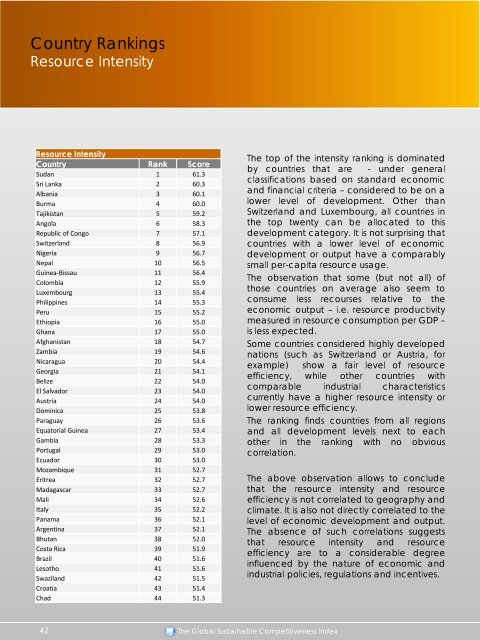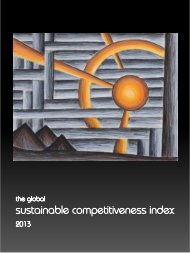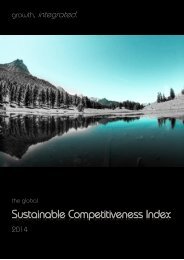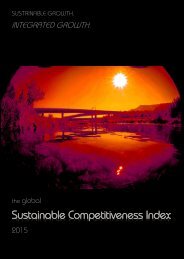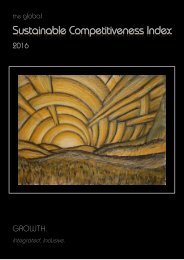Global Competetiveness Report
You also want an ePaper? Increase the reach of your titles
YUMPU automatically turns print PDFs into web optimized ePapers that Google loves.
Country Rankings<br />
Resource Intensity<br />
Resource Intensity<br />
Country Rank Score<br />
Sudan 1 61.3<br />
Sri Lanka 2 60.3<br />
Albania 3 60.1<br />
Burma 4 60.0<br />
Tajikistan 5 59.2<br />
Angola 6 58.3<br />
Republic of Congo 7 57.1<br />
Switzerland 8 56.9<br />
Nigeria 9 56.7<br />
Nepal 10 56.5<br />
Guinea-Bissau 11 56.4<br />
Colombia 12 55.9<br />
Luxembourg 13 55.4<br />
Philippines 14 55.3<br />
Peru 15 55.2<br />
Ethiopia 16 55.0<br />
Ghana 17 55.0<br />
Afghanistan 18 54.7<br />
Zambia 19 54.6<br />
Nicaragua 20 54.4<br />
Georgia 21 54.1<br />
Belize 22 54.0<br />
El Salvador 23 54.0<br />
Austria 24 54.0<br />
Dominica 25 53.8<br />
Paraguay 26 53.6<br />
Equatorial Guinea 27 53.4<br />
Gambia 28 53.3<br />
Portugal 29 53.0<br />
Ecuador 30 53.0<br />
Mozambique 31 52.7<br />
Eritrea 32 52.7<br />
Madagascar 33 52.7<br />
Mali 34 52.6<br />
Italy 35 52.2<br />
Panama 36 52.1<br />
Argentina 37 52.1<br />
Bhutan 38 52.0<br />
Costa Rica 39 51.9<br />
Brazil 40 51.6<br />
Lesotho 41 51.6<br />
Swaziland 42 51.5<br />
Croatia 43 51.4<br />
Chad 44 51.3<br />
The top of the intensity ranking is dominated<br />
by countries that are - under general<br />
classifications based on standard economic<br />
and financial criteria – considered to be on a<br />
lower level of development. Other than<br />
Switzerland and Luxembourg, all countries in<br />
the top twenty can be allocated to this<br />
development category. It is not surprising that<br />
countries with a lower level of economic<br />
development or output have a comparably<br />
small per-capita resource usage.<br />
The observation that some (but not all) of<br />
those countries on average also seem to<br />
consume less recourses relative to the<br />
economic output – i.e. resource productivity<br />
measured in resource consumption per GDP –<br />
is less expected.<br />
Some countries considered highly developed<br />
nations (such as Switzerland or Austria, for<br />
example) show a fair level of resource<br />
efficiency, while other countries with<br />
comparable industrial characteristics<br />
currently have a higher resource intensity or<br />
lower resource efficiency.<br />
The ranking finds countries from all regions<br />
and all development levels next to each<br />
other in the ranking with no obvious<br />
correlation.<br />
The above observation allows to conclude<br />
that the resource intensity and resource<br />
efficiency is not correlated to geography and<br />
climate. It is also not directly correlated to the<br />
level of economic development and output.<br />
The absence of such correlations suggests<br />
that resource intensity and resource<br />
efficiency are to a considerable degree<br />
influenced by the nature of economic and<br />
industrial policies, regulations and incentives.<br />
42<br />
The <strong>Global</strong> Sustainable Competitiveness Index


